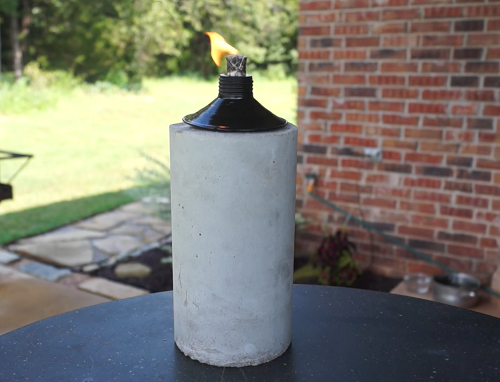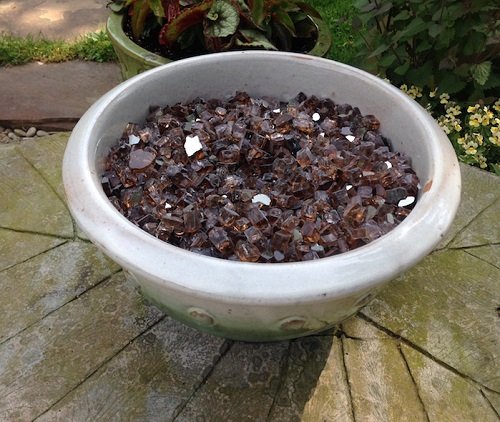These DIY Tabletop Fire Pit Ideas are perfect for a cozy evening where you could create a warm atmosphere in a small space!
Imagine having the mesmerizing allure of an open flame that not only warms up your surroundings but also adds a touch of elegance—wondering if it’s too complex or costly? Think again! In the following guide, we’ll walk you through simple yet stunning ways to create your own tabletop fire bowl. From chic minimalistic designs to rustic nature-inspired creations, we’ve got something that will set your decor ablaze. Keep scrolling for the best DIY Tabletop Fire Pit Ideas!
DIY Tabletop Fire Pit Ideas
1. Mini Tabletop Fire Pit
Visit The Art of Doing Stuff to learn how to make a fire pit that is cheap and perfect for your seating space.
2. DIY Concrete Tiki Torch
On Modern Builds, watch the tutorial for this Concrete Tiki Torch, which is perfect for your patio or picnic table!
3. Concrete Tabletop Fire Pit
This DIY concrete fire bowl project is super easy to complete, even for beginners and a great tabletop decoration idea. Find out the tutorial video here!
4. Easy Tabletop Fire Pit
If you’re an apartment dweller and love entertaining outside on your balcony or rooftop, this DIY tabletop fire bowl deserves a try.
5. Portable Fire Pit
Bring elements of nature into your tiny urban garden by adding a tabletop water feature and this fire pit. The step by step project is here to follow!
6. DIY Tabletop Firepit
Get rid of your fireless winter blues with this innovative DIY fire pit idea available on the Instructables!
Here are DIY Dry Riverbed Landscaping Ideas
7. Adirondack Fire Bowl Table
It’s a nice alternative if you don’t have space for a backyard firepit, it fire bowl table fits easily on a deck or small patio. Check out the informative tutorial here!
8. Glass Bowl Tabletop Fire Pit
Make this indoor glass bowl tabletop fire pit with the items you’ve around your home in just 10 minutes following the tutorial here!
9. Terracotta Fire Pit
Use a terracotta pot to create this inexpensive, warm tabletop fire pit to enjoy your evenings.
10. Lava Rock Fire Bowl
This mini fire bowl can fit on your smallest of tables and still provides enough heat to roast marshmallows. See the tutorial here!
11. Flower Pot Fire Pit
Your very own fire pit is hiding as an unused, overlooked flower pot somewhere in the corner. Find it out and make use of it to complete this DIY project here!
12. Tabletop S’more Fire Pit
If you aren’t sitting around the campfire but still looking for an alternative to have a S’more party? Try this idea here!
13. Gel Fire Pit
This DIY gel fire pit for tabletop can be your next sizzling conversation starter; view the DIY post here!
14. Tiki Torch Bottles
Use your liquor bottles to create these super hit tabletop attractions, following the directions available here!
15. S’mores Roasting Bar
Visit Bloglovin to find out the tutorial for this S’mores roasting bar, perfect for small gatherings!
16. Concrete Firepit
Build your own attractive concrete firepit from scratch following this step-by-step tutorial available here!
17. Tabletop Fire Pit Bowls
Beautiful, attractive, and colorful, create these tabletop fire bowls following the tutorial here!
Here are DIY Plant Risers for Indoor Plants to Make a Statement
18. Flaming Centrepiece
Make a beautiful flaming centerpiece with a galvanized bowl, tempered glass chips, and gel fuel, following the tutorial available at the BHG!
19. Ceramic Garden Pot Fire Pit
One more tabletop fire pit bowl tutorial that you can create in a garden pot. Visit Hobby Farms to see the how-to!
20. Neat Tabletop Fire Pit
This tabletop indoor firepit project can be completed for just $20. It’s decorative but functional as well, and you can roast marshmallows on it!
21. Cozy Fire Pit
Follow this excellent DIY post on HGTV to learn how to create this cozy and portable tabletop firepit!
Have a look at the best front yard landscaping ideas here
22. Fire Pit in a Bowl
Design a simple and portable fire pit using a bowl, making it easy to move and enjoy a crackling fire wherever you desire. Tutorial here.
23. Simple Table Top Fire Pit
Follow this DIY guide to create a straightforward tabletop fire pit that’s both beginner-friendly and versatile, ideal for various settings and occasions.
24. Fire Pit in a Fire-Resistant Container
Craft a safe tabletop fire pit within a fire-resistant container, ensuring a controlled and secure fire experience. Check the DIY here.
Here are Warm DIY Tabletop Fire Bowl (Fire Pit) Ideas For Small Spaces
25. DIY Tabletop Fire Pit
Follow this DIY to make your tabletop fire pit customizable to your preferences and ready for your next outdoor gathering. Here’s the DIY.
26. Tabletop Gas Fire Pit
Opt for the convenience of a tabletop gas fire pit with clay pots, providing a clean and hassle-free way to enjoy a controlled flame. Make it by following this DIY.
27. Non-Toxic Tabletop Fire Pit
Here’s a tabletop fire pit design that prioritizes safety, using non-toxic materials to create a worry-free fire feature. Find details here.
Check out DIY Hand Planter Tabletop Centerpieces here
28. Outdoor Tabletop Fire Pit
Construct an outdoor-specific tabletop fire pit that can withstand various weather conditions and enhance your outdoor living space. Make this low-cost DIY here.
29. Patio Tabletop Fire Pit
Enhance your patio decor with a stylish tabletop fire pit, perfect for entertaining guests and adding warmth to your outdoor gatherings. Find details here.
































I mean, who doesn’t love sitting around a fire? right?! If you re like me and want to watch a flickering flame without a lot of heat or the hassle of burning logs, then this easy tabletop fire pit bowl project is for you.
Great!!!
Thank you for sharing information.
I was looking for more of an actual “mini fire”. Like a real fire. These are all cute, but they’re all just basically candles! I want more flames, ya know?